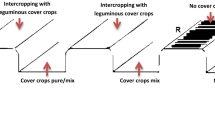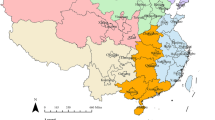Abstract
Under off-seasonality, high-value vegetable cultivation in the greenhouse is more profitable and gaining more acceptances day by day. This study aims to analyze the energy requirement and energy input–output relationship with the economics of vegetable-based cropping sequences viz., tomato nursery–tomato–pepper–onion nursery (CS1), tomato nursery–pepper–soil treatment–cucumber (CS2), tomato nursery–tomato–soil treatment–cucumber (CS3), tomato nursery–cucumber–soil treatment–pepper (CS4), and tomato nursery–tomato–soil treatment–pepper (CS5) in greenhouse conditions of Indian sub-Himalayas. The five sequential treatments were statistically analyzed in randomized block design with four replications. Results reveal that cucumber production required highest input energy (1,059.9 MJ/100 m2) than tomato or pepper. The highest input (3,477.4 MJ/100 m2) and output (4,787.5 MJ/100 m2) energy was observed with CS3. Crop protection (28.9–55.7 %), manures and chemical fertilizers (17.5–33.1 %), and plant stacking, training and pruning (16.3–21.9 %) consumed the bulk of the energy for all cropping sequences. The CS3 with the highest tomato equivalent yield produced the highest net energy (1,310.1 MJ/100 m2), energy productivity (0.63 MJ/100 m2), energy intensiveness (0.297 MJ/100 m2), and benefit/cost ratio (1.82). Energy consumption in the form of indirect (70.6–80.2 %) and non-renewable (83.9–85.7 %) energy was higher than direct and renewable energy, respectively. Considering these, CS3 (tomato nursery–tomato–soil treatment–cucumber) cropping sequence will be a more suitable option for greenhouse cultivation.


Similar content being viewed by others
References
Canakci, M., & Akinci, I. (2006). Energy use pattern analyses of greenhouse vegetable production. Energy, 31, 1243–1256.
De, D., Singh, S., & Chandra, H. (2001). Technological impact on energy consumption in rain-fed soybean cultivation in Madhya Pradesh. Applied Energy, 70, 193–213.
Devasenapathy, P., Senthilkumar, G., & Shanmugam, P. M. (2009). Energy management in crop production. Indian Journal of Agronomy, 54, 80–90.
Gomez, K. A., & Gomez, A. A. (1984). Statistical procedures for agricultural research (2nd ed., pp. 188–207). New York: John Wiley and Sons.
Heidari, M. D., & Omid, M. (2011). Energy use patterns and econometric models of major greenhouse vegetable productions in Iran. Energy, 36, 220–225.
Kuswardhani, N., Soni, P., & Shivakoti, G. P. (2013). Energy input–output and financial analyses of selected vegetables production in West Java, Indonesia. Energy, 53, 83–92.
Mandal, K. G., Saha, K. P., Gosh, P. L., Hati, K. M., & Bandyopadhyay, K. K. (2002). Bioenergy and economic analyses of soybean based crop production systems in central India. Biomass and Bioenergy, 23, 337–345.
Ozkan, B., Akcaoz, H., & Karadeniz, F. (2004). Energy requirement and economic analysis of citrus production in Turkey. Energy Conversion and Management, 45, 1821–1830.
Ozkan, B., Fert, C., & Karadeniz, C. F. (2007). Energy and cost analysis for greenhouse and open-field grape production. Energy, 32, 1500–1504.
Singh, H., Mishra, D., Nahar, N. M., & Ranjan, M. (2003). Energy use pattern in production agriculture of a typical village in arid zone India: part II. Energy Conversion and Management, 44, 1053–1067.
Singh, H., Singh, A. K., & Kushwaha, H. L. (2007). Energy consumption pattern of wheat production in India. Energy, 32, 1848–1854.
Singh, K. P., Prakash, V., Srinivas, K., & Srivastva, A. K. (2008). Effect of tillage management on energy-use efficiency and economics of soybean (Glycine max) based cropping systems under the rain-fed conditions in North-West Himalayan Region. Soil and Tillage Research, 100, 78–82.
Soni, P., Taewichit, C., & Salokhe, V. M. (2013). Energy consumption and CO2 emissions in rain-fed diversified agricultural production systems of Thailand. Agricultural Systems, 116, 25–36.
Tuti, M. D., & Das, T. K. (2011a). Carry-over effect of metribuzin applied to soybean (Glycine max) on weeds and wheat (Triticum aestivum) under zero and conventional tillage. Indian Journal of Agronomy, 56, 121–126.
Tuti, M. D., & Das, T. K. (2011b). Sequential application of metribuzin on weed control, growth and yield of soybean (Glycine max). Indian Journal of Agronomy, 56, 57–61.
Tuti, M. D., Pandey, B. M., Bhattacharyya, R., Bisht, J. K. & Bhatt, J. C. (2011). Integrated assessment of vegetable-based relay intercropping systems in the north-western Himalaya. In: Abstracts and souvenir, 6th Uttarakhand State Science & Technology Congress, 14–16 November, Uttarakhand State Council for Science and Technology, Kumaon University, Almora, India; p. 17.
Tuti, M. D., Prakash, V., Pandey, B. M., Bhattacharyya, R., Mahanta, D., Bisht, J. K., et al. (2012). Energy budgeting of colocasia-based cropping systems in the Indian sub-Himalayas. Energy, 45, 986–993.
Acknowledgments
This research is a part of the Horticulture Mission for North-East and Himalayan States, MM-I project. We sincerely thank Nodal Officer, HMNEH/Director, VPKAS, Almora, Uttarakhand for providing the financial support and encouragements during the course of the study.
Author information
Authors and Affiliations
Corresponding author
Rights and permissions
About this article
Cite this article
Hedau, N.K., Tuti, M.D., Stanley, J. et al. Energy-use efficiency and economic analysis of vegetable cropping sequences under greenhouse condition. Energy Efficiency 7, 507–515 (2014). https://doi.org/10.1007/s12053-013-9239-1
Received:
Accepted:
Published:
Issue Date:
DOI: https://doi.org/10.1007/s12053-013-9239-1




